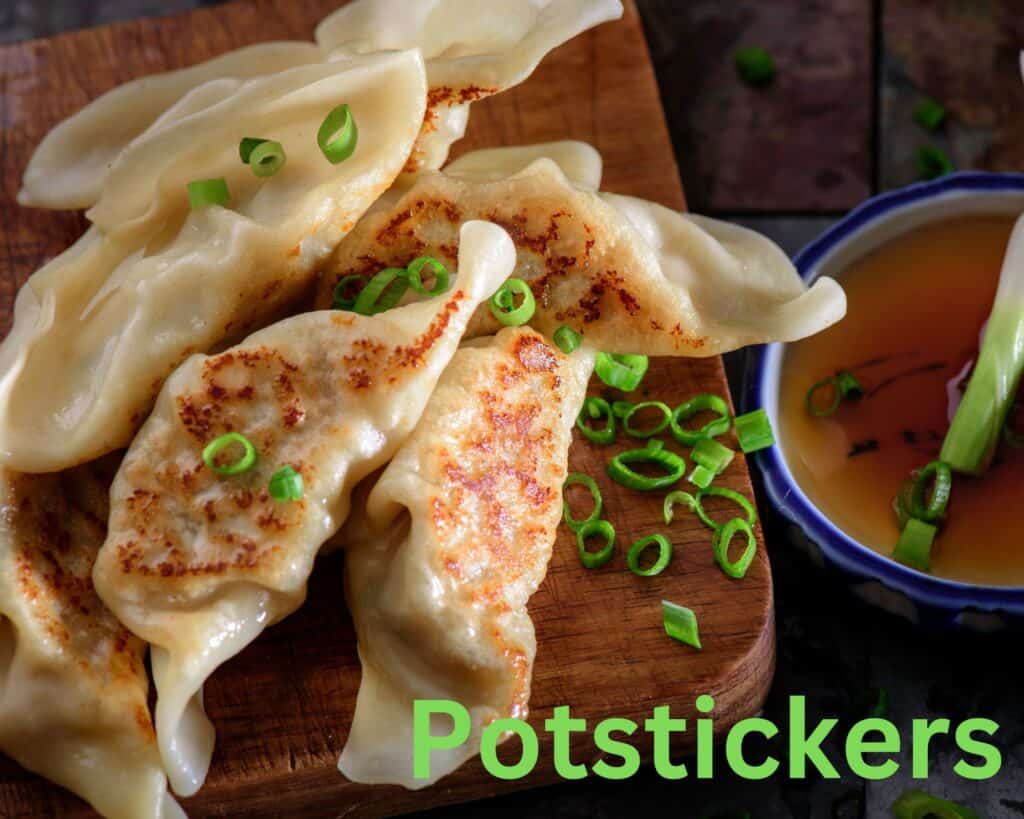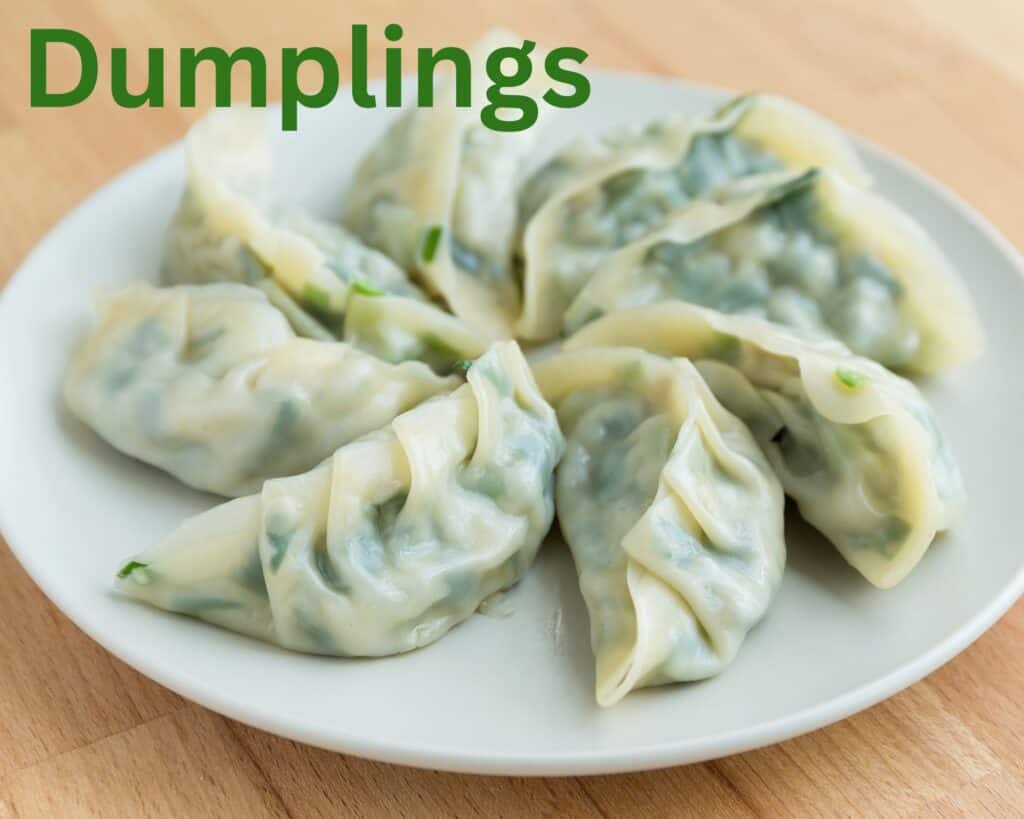If you’ve ever been to a Chinese restaurant and seen both potstickers and dumplings on the menu, you could be forgiven for having been confused. A lot of people don’t know the distinctions between these two and might even think that it’s just two names for the same dish.
We have wonderful news for you. Not only are potstickers and dumplings different (sort of) but there are hundreds of variations on these delicious dishes.

What Are Potstickers?
Potstickers are always dumplings, but not all dumplings are potstickers. The biggest difference between these two are how they are cooked, but the cooking method has also changed the kinds of ingredients and preparation of both potstickers and dumplings over time.
Potstickers are dumplings that are also pan-fried. One of the possible origins of potstickers involves a Chinese chef intending to boil dumplings, accidentally walking away for too long, and letting all the water in their wok boil off. The dumplings stuck to the bottom of the pan until they formed a crispy browned skin that let them be removed, which also explains the potsticker name.
So potstickers are generally a thin case of dough around a filling that are then steamed and pan-fried till done.
There are lots of different types of potstickers, and plenty of cultures have their own versions of potstickers, like the pierogi common in central and eastern Europe.

Different Types of Potstickers
Most people think of the traditional Chinese potsticker when they think of this dish, but there are plenty of other dumplings that count as potstickers depending on how they are prepared, including many versions from other regions and culture’s cuisines.
We’ve included a couple of other versions here as well.
- Potstickers: The classic Chinese potsticker is a combination of cabbage, pork, shitake mushrooms, and sometimes other ingredients, tightly wrapped in relatively thin dough then steamed or boiled, and finally pan-fried in a small amount of oil.
- Gyoza: Japanese Gyoza are similar to Chinese potstickers, and often use similar ingredients, including pork, mushrooms, and cabbage. Though other seasonings and vegetables are often slightly different. Gyoza are cooked the same way but often have thinner wrappers.
- Pierogi: Pierogi are common throughout central and eastern Europe, and often contain a cooked and seasoned potato and cheese mash wrapped in dough and boiled then pan-fried. However, other fillings are available, including mushrooms, sauerkraut, and meat.
- Kreplach: Kreplach aren’t always potstickers, they can also be a soup dumpling, but they can be served fried like a typical potsticker as well. Often filled with ground meat, potatoes, and veggies, these Jewish potstickers are savory, filling, and delicious.
How Do You Make Potstickers?
Potstickers are, at their core, two thing. Filling + dough wrapper. Typically wrappers are unleavened and can be just flour and water, or a combination of flour, water, and egg. Fillings are often a combination of pre-cooked and drained vegetables with cooked or uncooked meat, and occasionally egg or tofu as a binder ingredient.
The trick is carefully folding and sealing potstickers so they don’t burst open or crack during cooking. Otherwise, the textures will be ruined by the water, and they’re likely to be a soggy, if tasty, mess.
A quick steam or boil is always followed by pan-frying or baking potstickers.
Some dumplings are deep-fried, but we’ve decided those are distinct from potstickers since they tend to be crunchy all round, while a great potsticker should be a combination of crunchy and chewy bits of wrapper, with a flavorful often soft filling.
Delicious Potsticker Ingredients
Cabbage and pork are probably the two single most popular filling for east-Asian potstickers, but there are a lot of variations when you look at other parts of the world as well. Here are some examples: Pork, cabbage, tofu, onion, carrots, mushrooms, celery, garlic, potatoes, cheese, sour cream, green onions, spinach, fresh herbs, chives, ground meat, or meat cubes.
Great Potstickers Recipes You Should Try
If you’re looking for great potsticker recipes, The Novice Chef’s recipe has a great combination of traditional ingredients and flavors plus water chestnuts and bamboo shoots for even more texture and flavor in your finished potsticker.
Sticking with the traditional, Just One Cook Book has a delectably savory recipe for Japanese gyoza, with step-by-step instructions and an explanation of what makes gyoza different from Chinese potstickers.

What Are Dumplings?
Dumplings are even more widely varied than potstickers. The main two requirements are a wrapper and filling that will be steamed or boiled to cook. But some dumplings, like gnocchi or the classic dumplings in chicken and dumpling soup, are just a kind of boiled dough that is distinct from pasta.
Sound confusing?
For this article, we’re going to limit the definition of dumpling to a sealed wrapper with filling, and a little more to unleavened wrappers, which excludes bao buns and other leavened dough buns that could otherwise be dumplings.
But, any filling, in any unleavened wrapped that gets boiled or steamed to cook counts. There are a lot of different dumplings in the world.
Different Styles Of Dumplings
There are thousands of different kinds of dumplings, so we can’t possibly cover them all here. But, we’ve chosen a range of styles to demonstrate some of the differences and show how dumplings are an incredibly cross-cultural dish.
- Jiaozi: Jiaozi is the proper name for the Chinese dumpling you’re probably most familiar with and can be turned into potstickers when pan-fried. The filling can be the same pork, mushroom, and cabbage combination common to potstickers and gyoza, or a completely different combination of protein and vegetables.
- Kinkali: A Georgian dumpling (the country, not the state) is shaped like a bulb of garlic with a long stem, and contains spiced ground meat, fresh herbs, garlic, and onions and is boiled and served on its own or as a side dish.
- Soup Dumplings: There are versions of soup dumplings all over East Asia, but the trick to these beauties is a perfectly sealed wrapper, along with a meat and veg filling, and small cubes of a solidified fatty broth that turns liquid while the dumpling cooks. That fills this style of dumpling with a rich aromatic broth that bursts out when you bit into the dumpling.
- Mandu: Mandu are Korean dumplings, which are typically made in a more cylindrical shape, and contains ground pork, vegetables, tofu, kimchi, and sometimes cooked rice noodles. Also made into a flavorful soup, Mandu-guk.
- Manti: Manti are Turkish dumplings, though they’re eaten throughout Central Asia. Stuffed with seasoned ground lamb or beef, and served with a yogurt or butter-based sauce, these are some of the most delicious and savory dumplings anywhere.
How Do You Make Dumplings?
Like potstickers, the biggest challenge with dumplings is getting the wrapper well sealed so that it contains the flavors of the dumpling well.
Take a seasoned and flavorful filling, shape it, and wrap a thin layer of dough around it, and you have a basic dumpling. Boil or steam them to keep them distinct from potstickers and fried versions (like samosas), and you’re ready to eat!
Dumplings are also commonly eaten like pasta, with a sauce, or in soups in different parts of the world. So feel free to experiment with different ways to turn these scrumptious side dishes into an exciting main course.
Dumplings Ingredients and Toppings To Experiment With
Normally we’d list off a bunch of ingredients here, including the common cabbage, pork, and mushroom fillings, but instead, this time we’d like to encourage you to get creative.
Try a lamb and spinach dumpling, or combine peas or chickpeas with aromatic spices and rich vegetables, or consider a simpler potato and meat dumpling. Just about any combination of flavors you can think of, can also be turned into a flavorful dumpling.
Or look up the regional dumpling of your choice! You’ll find that almost every cuisine has at least one take on a dumpling.
Top Dumplings Recipes You’re Sure To Love
While there are dumplings served all over the world, we’ve decided to stick to the East Asian dumplings most people think of for our recipes.
This Woks of Life recipe is one of the most flavorful versions of Chinese dumplings we’ve ever found, and teaches you both the dumpling and potsticker cooking method!
Ready to up your dumpling game with a real challenge? Woks of Life also has an excellent soup dumpling recipe that will walk you through every step of this complicated process, making it easy, understandable, and a lot simpler to make ahead.
Wrapping Up: What are the key differences between Potstickers and Dumplings?
The key difference between a potsticker and a dumpling? How it’s cooked. Potstickers are pan-fried after steaming or boiling, while dumplings are just steamed or boiled.
There are a TON of different versions of both of these dishes, so it’s really impossible to categorize all the other differences, aside from the core. But, that just means that there’s a whole world of dumplings and potstickers for you to explore in your cooking.
If you’re looking for another bite-sized pocket of goodness, take a look at our Pizza Pocket recipe!
Frequently Asked Questions (FAQs)
Q1: Are Dumplings or Potstickers Healthier?
This is really down to the filling, for how healthy an individual dumpling or potsticker is. They’re almost always very carb-rich thanks to the wrapper, and vegetarian and vegan versions of both are typically lower calorie and high nutrient than ground-meat-based versions. That said, potstickers tend to have more fat, thanks to pan frying, than any dumplings except soup dumplings.
Q2: Are Chinese Dumplings Called Potstickers?
No, dumplings and potstickers are two different things, depending on the preparation. But technically, they can be prepared the same way until you cook them and still be two different dishes.
Q3: What is the Difference Between Japanese and Chinese Potstickers?
There are subtle differences between the Chinese and Japanese versions of a potsticker, like slightly different amounts of soy sauce, cooking wine, oyster sauce, and aromatics like ginger, as well as a difference in the thickness of the potsticker wrapper. Chinese potstickers tend to have a thicker wrapper, while Japanese gyoza wrappers are thinner, sometimes to the point of being translucent.
Q4: Why are Potstickers So Expensive?
The ingredients in a potsticker or dumpling are usually very affordable, but making them is a difficult and painstaking process, which is why they can be expensive in restaurants and stores. Making them yourself is probably cheaper, but it can take a long time to produce a large batch of potstickers.
The good news is that uncooked potstickers and dumplings tend to freeze well, so you can make a large batch and freeze some for later.
Potstickers vs Dumplings

Ingredients
Instructions
- Select your favorite recipe
- Click the link to view the instructions
- Follow the linked instructions
- Enjoy!

